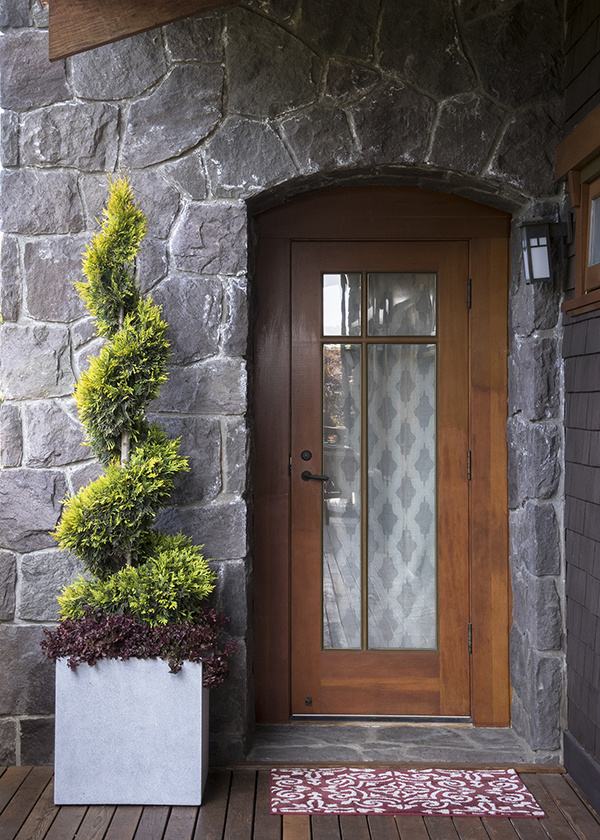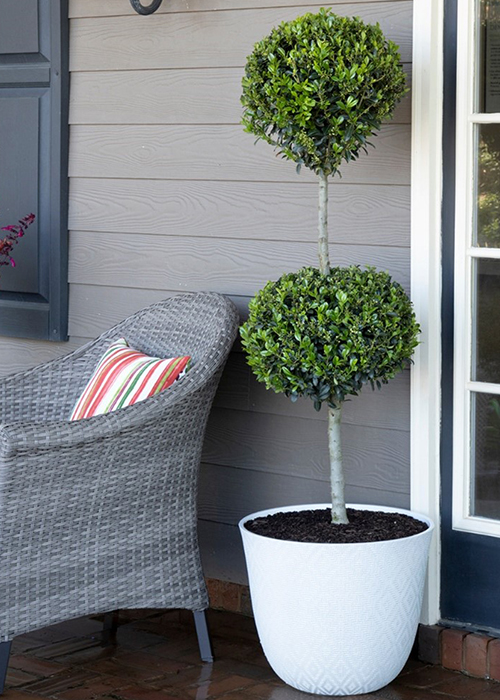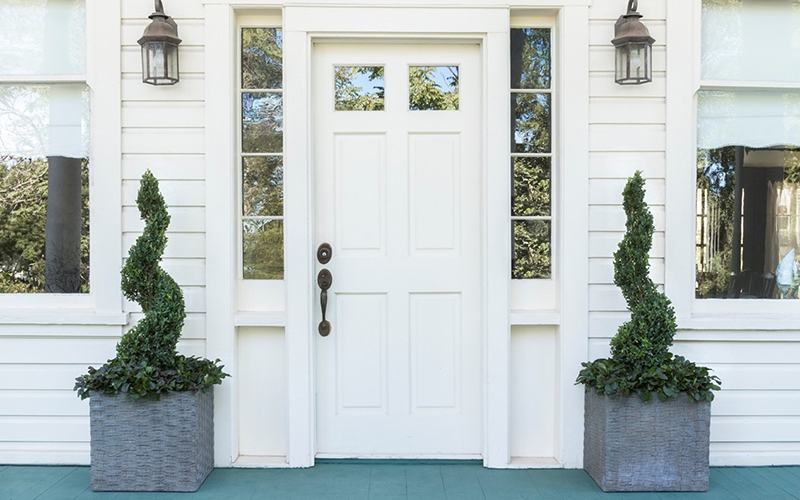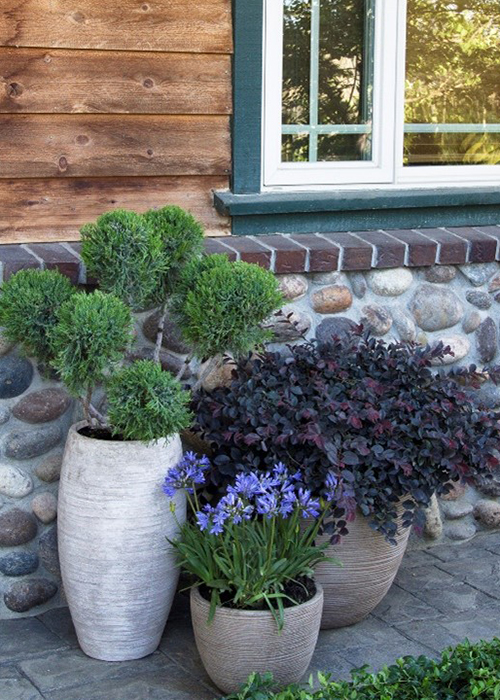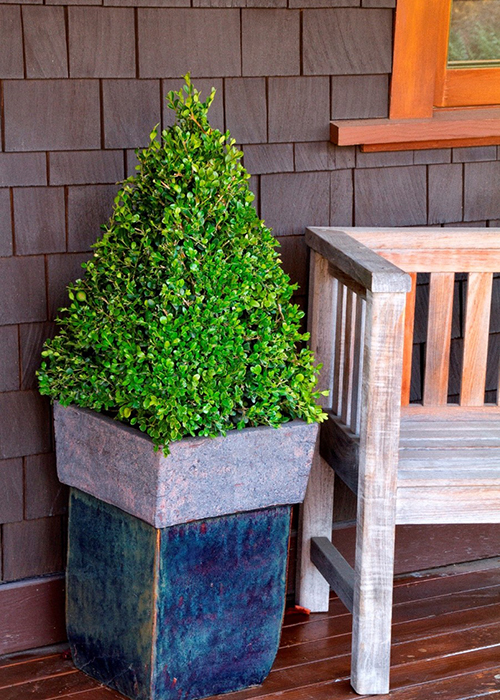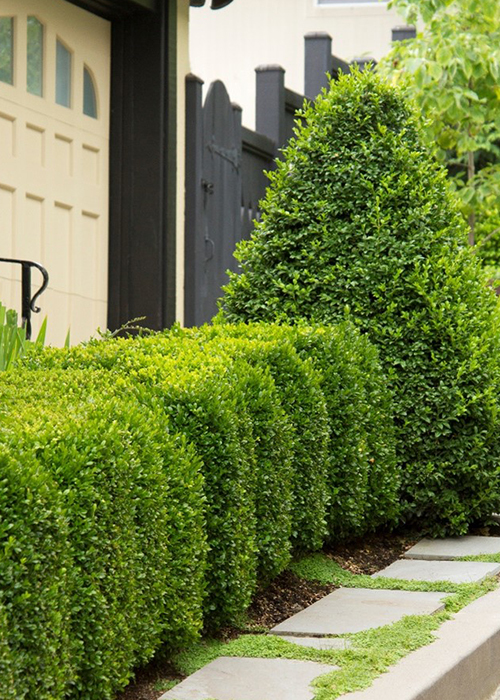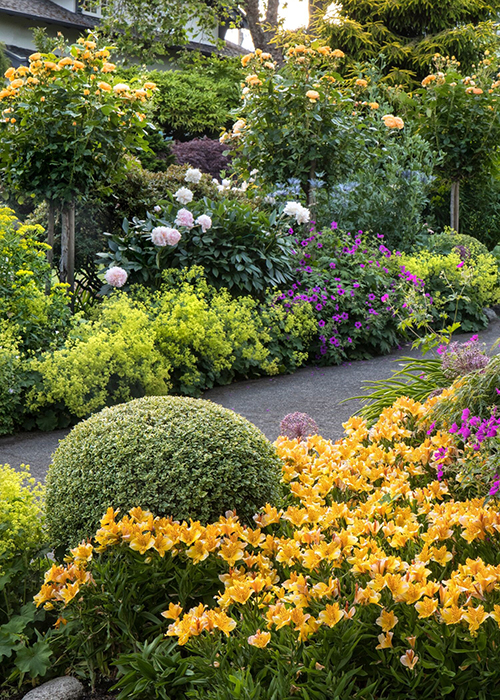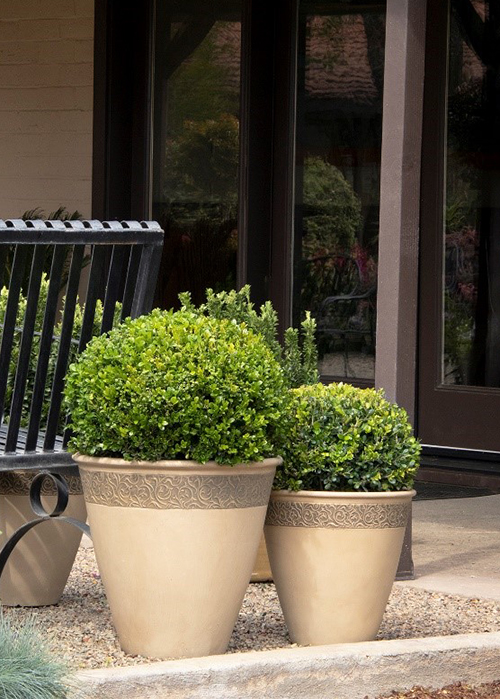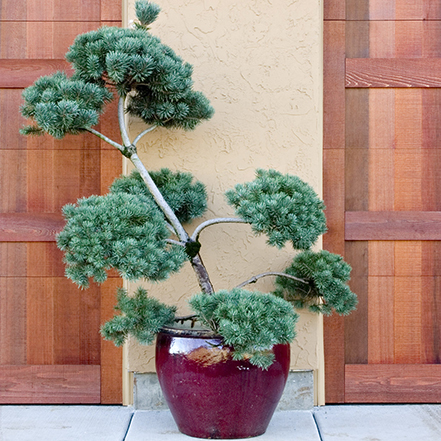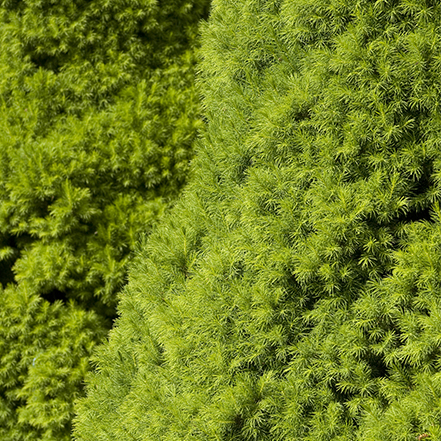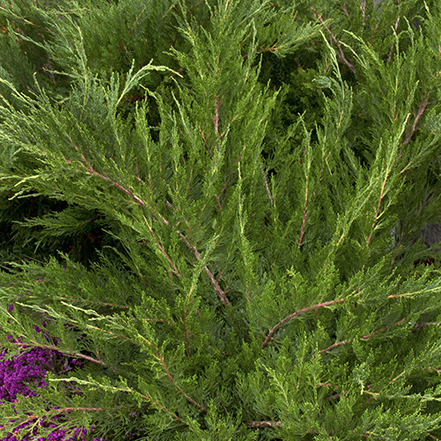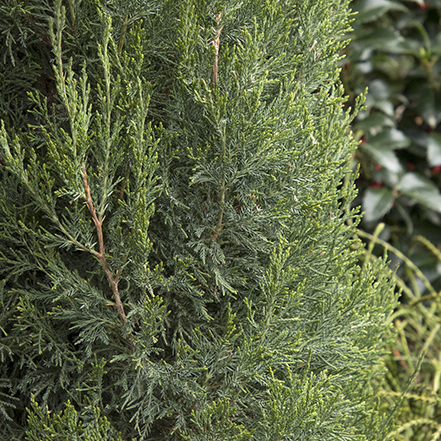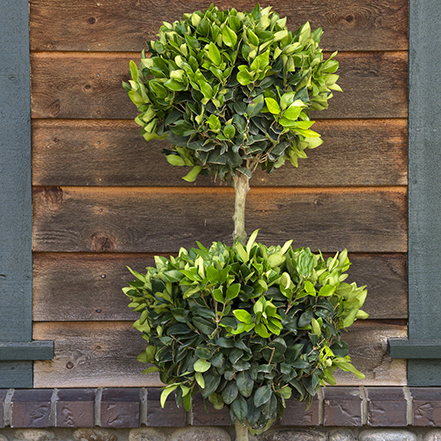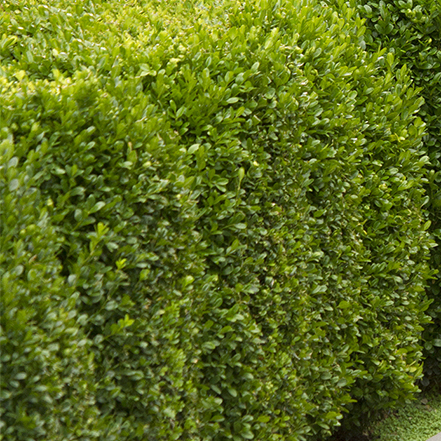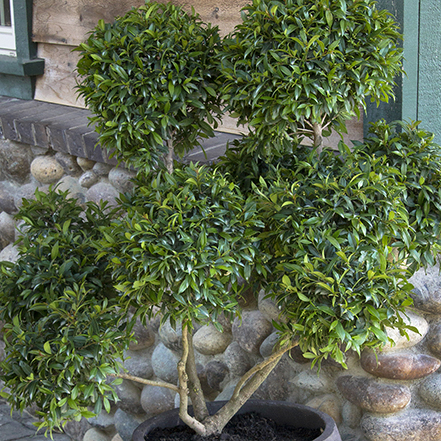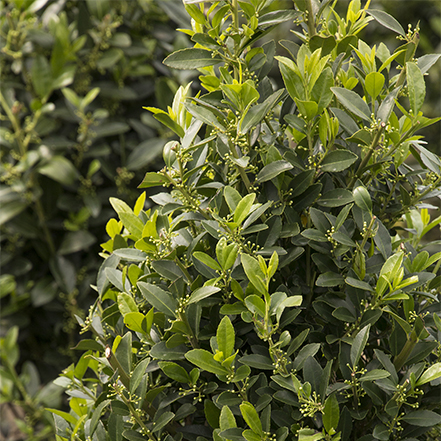Whether you are creating a formal front entry, a serene zen garden, or simply trying to add a touch of whimsy, topiaries can serve a variety of functions in the garden.
Growing and training topiaries takes skill and years of work. Luckily, when you buy a Monrovia topiary, those years of work have already been done!
Unfortunately, you can’t take one of our craftsmen home with you, and many people worry about having to take over the job of caring for a topiary. Don’t worry, we’re here to tell you everything you need to know about maintaining your beautiful specimen.
Buying online? Topiary options will be listed in the container size dropdown menu.
Table of Contents
- Types of Topiary Shapes and How to Use Them
- How to Plant Topiaries
- Containers
- In the Ground
- How to Care for Topiaries
- Watering
- Fertilizing
- Pruning
- Winter Care
- Best plants for topiary
Types of Topiary and How to Use Them in Garden Design
Spirals and Poodles
The tall, narrow silhouettes of spirals and poodle forms (two- or three-balls stacked vertically) are great when used in pairs on either side of an entry. They can fill in a space between doors and windows, and a backdrop of a blank wall allows the sculptural form to be seen clearly from the sidewalk. The result is a formal, elegant look.
Alternatively, a well-placed specimen in the landscape can become a whimsical focal point. Try using it in the center of a loop of a path so it can be appreciated from all sides.
Two simple boxwood spiral planters transform this front porch. A particularly effective technique for houses with symmetrical fronts.
Pompoms
A small juniper pompom makes a nice addition to a collection of container plantings. Baby Pete Agapanthus and Sizzling Pink Fringe Flower complete the collection.
Pompoms have a unique, eye-catching form and are best used singly, as a central focal point. Smaller specimens can work well in containers or as a fun addition by a small pond or water feature.
Larger plants look great in the center of a large bed in gardens that mimic nature. Planting at the top of a mound can really let them shine and have space to show off. Decorative rocks complete the look.
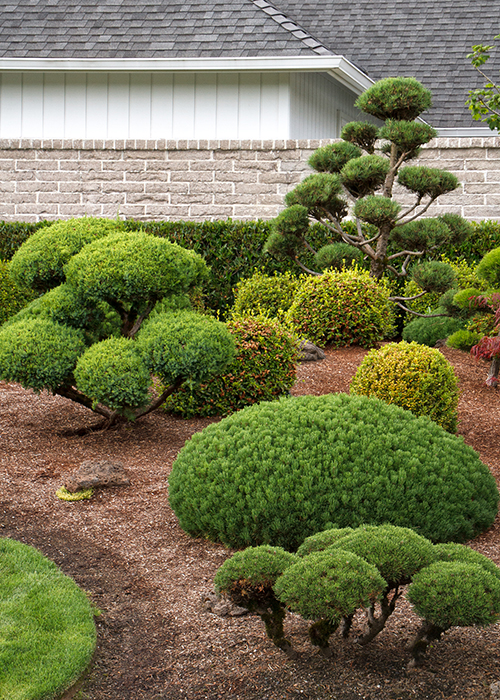
Pompom Trees have a central trunk and mimic the tiered shape of a large, mature pine in nature. They are a must-have in Asian-style and zen gardens. In large areas, they can be repeated in multiple places throughout the landscape, making sure they are placed in a way that looks natural rather than evenly spaced.
Cones and Pyramids
Cones and pyramids are a great way to add consistent height in containers, either planted alone or with other plants. They are another great option for either side of a front door for a look that is tidy, but a little more reserved than a spiral.
Cones are also great anchors at the end of planting beds, and incorporating one to the end of a low hedge can help define the stopping point.
Globes
While a perfectly formed globe may make you think of formal European gardens, they have become a popular element in upscale, modern landscapes. Globes look great alone in containers and are a fantastic compliment to contemporary architecture with straight, sleek lines.
Globes can also be used sporadically in rustic garden beds to contrast flowy perennials and look particularly interesting surrounded by ornamental grasses.
How to Plant Topiaries
How to plant topiaries in containers
Choose a planter that is at least 6-12" wider than the root ball of the conifer it will contain, but not more than twice the size of the plant’s nursery pot. This will allow for a few years of growth before having to transplant.
For taller plants, make sure the pot is heavy enough to provide a sturdy base that won't topple in high winds. The pot you use should also have drainage holes. Container plants should be occasionally rotated for even sun exposure, especially if they are up against a building.
How to plant topiaries in the garden
Dig a hole 2-to-3 times wider than the root ball, but only as deep as the height of the root ball. The root flare at the base of the trunk should be just above soil level, never below. Backfill with native soil, tamping down well to get rid of air pockets. Water very well, allowing the water to seep into the soil before watering some more. If the water is still seeping into the soil very quickly, keep watering!
Mulch the base of the plant 2" deep, making sure to keep it off the trunk. If your topiary is very tall (6' or taller) and will be planted in a windy, unprotected area, stake it for the first year while the roots get established.
How to Care for Topiaries
How to Water Topiaries
Check the label on your plant to learn its water needs. Remember that plants in containers need to be watered more often than plants in the ground. Continue to monitor the soil moisture to make sure your watering schedule is effective. The best way to check is simply to stick your finger into the soil. Hey, we never said you wouldn’t get dirty!
How to Fertilize Topiaries
Topiaries in containers need to be fertilized every year. Apply a slow-release fertilizer in spring as new growth begins.
In the ground, fertilizing in the first year or two can help the plant get off to a good start, but continual fertilizing may not be necessary unless your soil has nutrient deficiencies. A yearly top dressing of compost is a good practice to ensure healthy soil.
How to Prune Topiaries
With topiaries, pruning lightly but often is the best way to maintain a tidy shape. Pruning can be done two to four times a year, depending on how the plant grows and how well-manicured you want to keep your topiary.
Pruning cuts should leave some new growth behind and not go back farther than previous pruning cuts. Because of this, it is the growth of the plant that will determine your pruning schedule. Do your first pruning cuts in spring after the first new growth. Prune again after another push of new growth, generally in summer. Depending on your climate, your plant might put on enough summer growth to allow for another pruning in late summer or perhaps a final fall pruning.
Exactly how much you take off will depend on how the plant grows. Some plants, like the Dwarf Alberta Spruce, grow slowly and evenly around the whole plant. You might find you are only removing half an inch of growth in order to keep some of the fresh growth on the plant. Other plants might have more shaggy growth.
Cutting back the longest growth so that all foliage is at an even height can be a good technique. Not sure how much to cut off? Start by being conservative with just a light trim. You can always take off more, but you can’t put it back! You might feel like you are barely taking anything off, but afterward, when you stand back you’ll see it made a big difference. Never cut your topiaries all the way back to bare stems.
If you just have some unruly sprigs that need a little trim, clippers can be enough to do the job. If it’s time for a full, top-to-bottom prune, you’ll probably want to get out your shears. Hedge shears are the most efficient for large plants. Smaller grass shears can be easier to wield and work well for smaller topiaries.
For rounded forms such as spirals and balls, slowly roll the shears around the shape of the curve as you make your cuts. For cones, make the cuts vertically for nice straight sides, rather than trying to cut horizontally in a rounded fashion.
A Note on Pines
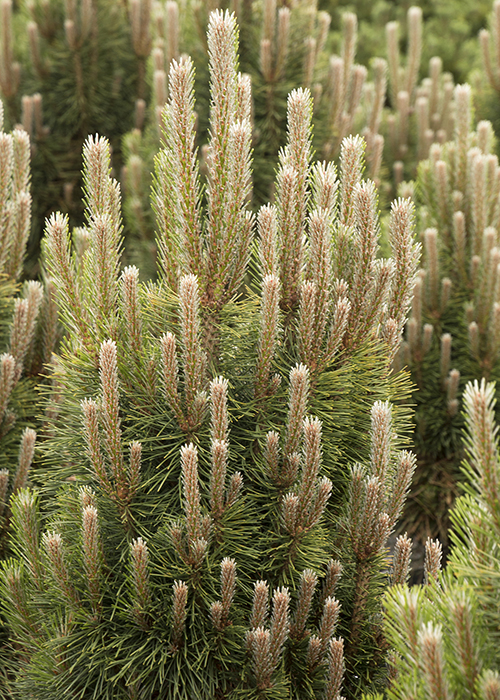
The candles on this Frank’s Austrian Pine are ready to trimmed.
Pines grow by sending up “candles”. These light-colored upright spires grow to their full length before pushing out new needles. The best way to prune pines is with a technique called “candle pinching”. Cut the candles back to the length you would like your new sprig of growth to be.
This can be done by hand with a twisting pinch, or with clippers. You will only need to trim your pine once a year. For oriental pompoms, you might prefer to prune less often for a more natural look.
Winter Care for Topiaries
Since most topiaries are evergreen, they can be subject to winter burn in cold climates. Winter burn happens when plants lose more water from their foliage than they can bring up from the ground. This usually is caused by a combination of cold, drying winds and frozen soil. If that combination is common during your winters, you’ll want to make sure your topiary has some protection from the prevailing winds.
If you locate your topiary out in the open without protection, you might need to create a temporary windbreak, which can be done with stakes and burlap. You can also wrap a plant with fabric. Check your local garden center for cold protection options.
As one of the hardier broadleaf evergreens, boxwood is often planted in areas where winter burn can be a problem. You can read more about boxwood winter care here.
Best Plants for Topiary
Best Conifers for Topiary
French Blue
Scotch Pine
This variety of a popular evergreen tree has lovely blue needles and a more uniform, compact growth habit. We’ve trained them into artful oriental pompons. Full sun. Up to 60' tall, 25' wide in natural form in the landscape. Zones 2-7.
Dwarf Alberta
Spruce
A dwarf conifer that is extra root hardy, though it needs protection from winter winds. The slow growth can reduce the amount of pruning that needs to be done. The natural cone shape transforms beautifully into a spiral. Also available in poodle cuts. Up top 8' tall, 5' wide in natural form. Zones 2-8.
Mint Julep
Juniper
Naturally growing in a sprawling form, the pliable branches of Mint Julep allow it to be trained into almost any shape imaginable. We’ve created spirals, pom poms, poodles, and globes out of this versatile plant. Junipers are tough, being both winter-hardy and tolerant of hot sun, making them a great choice for the south side of a house. Full sun. Up to 6' tall, 8' wide in natural form. Zones 3-9.
Spartan
Juniper
Naturally tall and slender, this strongly upright grower is great for making larger topiaries. If you’re wanting a high-impact, tall spiral for your landscape, this is the conifer for you. Also available in 2- and 3-ball poodle cuts. Full sun. Up to 15' tall, 5' wide in natural form. Zones 4-9.
Best Broadleaf Evergreens for Topiary
Waxleaf
Privet
Tolerant of hot, dry conditions, Waxleaf Privet has the largest leaves of the topiary options, providing a coarser texture. The showy white flower clusters are loved by bees, but you’ll have to skip some pruning if you want to enjoy them. Available as a pyramid, spiral, cone, or poodle. Partial to full sun. Up to 10' tall, 6' wide in natural form. Zones 7-11.
Green Mountain
Boxwood
This boxwood grows in an upright habit, making it the perfect candidate for cones, pyramids, and spirals. The most cold hardy of the broadleaf evergreens, it can tolerate more shade than a conifer, making it a good option for the east side of a house or on covered porches. Partial to full sun. Up to 5' tall, 3' wide in natural form. Zones 4-9.
Dwarf
Brush Cherry
Great for warmer climates, brush cherry will provide some extra color, with bronze-red new foliage. We’ve found it makes great cones, pompons, spirals, and poodles. Given some time after pruning, you can enjoy sporadic, tiny white flowers. Partial to full sun. Up to 6' tall and wide in natural form. Zones 9-11.
Emerald Colonnade®
Holly
The small foliage of this male, fruitless holly gives it a boxwood-like appearance but with the ability to create much taller forms. Growing naturally in a cone shape, we use it to create pyramids, poodles, and spirals. Full sun. Up to 12' tall, 8' wide in natural form. Zones 7-11.
Learn More About Gardening with Evergreens
- Sign up for our Grow Beautifully newsletter. You'll get more design inspiration, garden tips, how-tos, and first access to exclusive plants.
- Best Conifers for Containers (And how to care for them)
- Your Complete Guide to Growing and Caring for Conifers
- Use These Colorful Conifers to Transform Your Landscape
- The Best Dwarf Conifers Offer Big Solutions
- Best Evergreen Shrubs for Privacy
- How to Match the Best Evergreen Shrub to Your Landscape Need
- Colorful Cold-Loving Conifers for the Winter Garden
- Boxwood Winter Care
- Tips for Growing Pyracantha




